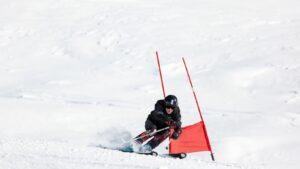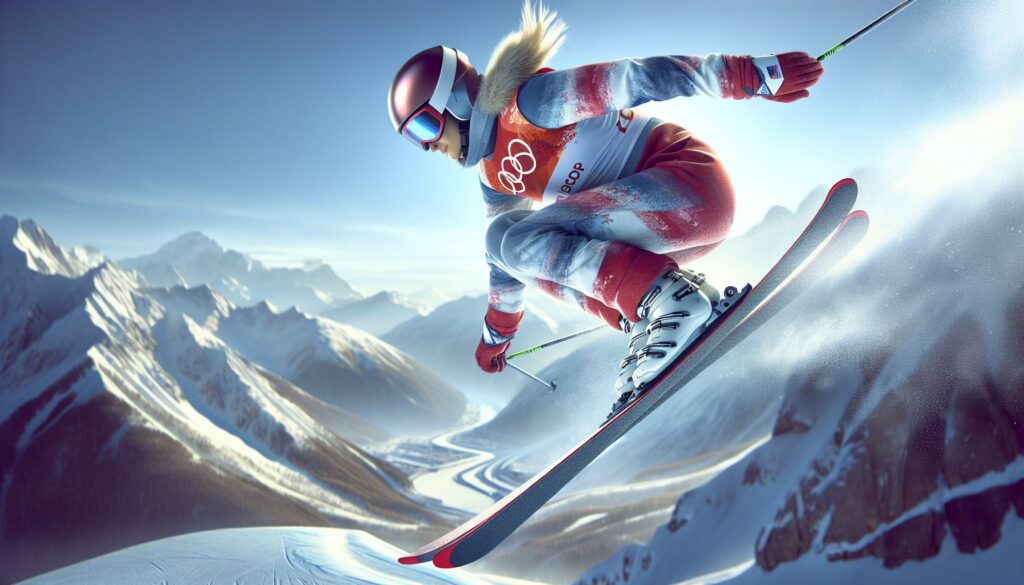As a lifelong winter sports enthusiast, I’ve always been captivated by the breathtaking performances at the Olympic skiing events. From the heart-pounding downhill races to the graceful aerial maneuvers in freestyle skiing, these competitions showcase the pinnacle of human athleticism on snow.
Since its official debut at the 1936 Winter Olympics in Garmisch-Partenkirchen, Olympic skiing has evolved into a spectacular display of diverse disciplines. Today’s Games feature 11 different skiing events, including alpine, cross-country, and freestyle competitions. I’ve watched in awe as athletes like Mikaela Shiffrin and Marcel Hirscher have pushed the boundaries of what’s possible on the slopes, setting records and inspiring millions around the world.
Skiing Olympics
- Olympic skiing debuted at the 1936 Winter Games, evolving from a single combined event to 11 diverse disciplines across alpine, cross-country, and freestyle categories

- The most decorated Winter Olympians in skiing include Marit Bjørgen (15 medals) and Bjørn Dæhlie (12 medals), setting impressive records in Nordic skiing events
- Alpine skiing features five main events: Downhill, Super-G, Giant Slalom, Slalom, and Combined, each testing different aspects of speed and technical skill
- Modern Olympic skiing has been transformed by technological innovations, including carbon fiber skis offering 40% more stability and advanced course designs with computer-modeled snow production
- Notable achievements include Ester Ledecká’s historic 2018 dual-sport gold medals in both alpine skiing and snowboarding, demonstrating the evolution of Olympic skiing talent
The History of Olympic Skiing Events
Olympic skiing events trace their roots to the 1936 Winter Games in Garmisch-Partenkirchen, Germany, marking the beginning of a transformative journey in winter sports competition.
Evolution of Alpine Skiing in the Olympics
Alpine skiing debuted at the 1936 Winter Olympics with a combined event featuring downhill and slalom races. The sport expanded in 1948 to include three distinct events:
- Downhill racing on steep courses with speeds reaching 80 mph
- Giant slalom with wider turns through 40-50 gates
- Slalom racing through tightly spaced gates at 30-35 mph
Key developments in Alpine skiing include:
- Introduction of super giant slalom (Super-G) in 1988
- Addition of Alpine combined events in 1936
- Implementation of parallel team events in 2018
| Olympic Year | New Alpine Events Added | Total Alpine Events |
|---|---|---|
| 1936 | Combined | 1 |
| 1948 | Downhill, Slalom, Giant Slalom | 4 |
| 1988 | Super-G | 5 |
| 2018 | Team Event | 6 |
Nordic Skiing’s Olympic Journey
Nordic skiing appeared in the first Winter Olympics in 1924 in Chamonix, France. The discipline started with:
- 18km cross-country skiing for men
- 50km cross-country marathon
- Nordic combined (skiing + ski jumping)
- Women’s cross-country events added in 1952
- Sprint events introduced in 2002
- Team sprint competitions launched in 2006
| Nordic Event Type | Olympic Introduction Year | Gender Categories |
|---|---|---|
| Cross-Country | 1924 | Men |
| Nordic Combined | 1924 | Men |
| Women’s Cross-Country | 1952 | Women |
| Team Sprint | 2006 | Both |
Most Memorable Olympic Skiing Moments
Olympic skiing has produced extraordinary moments that have captivated audiences worldwide. These instances showcase athletic excellence, determination, and the relentless pursuit of glory on the snow-covered slopes.
Record-Breaking Performances
- Jean-Claude Killy dominated the 1968 Grenoble Olympics with three gold medals in all alpine skiing events: downhill, giant slalom, and slalom.
- Bjørn Dæhlie secured 12 Olympic medals (8 gold, 4 silver) across three Winter Games (1992-1998), establishing the record for most Winter Olympic medals.
- Janica Kostelić became the first alpine skier to win four medals in a single Olympics at the 2002 Salt Lake City Games.
- Marcel Hirscher set a record with 8 consecutive World Cup overall titles (2012-2019) before winning his first Olympic golds in 2018.
- Franz Klammer’s 1976 downhill victory in Innsbruck featured a daring run that secured Austria’s first gold in the event.
- Alberto Tomba’s back-to-back giant slalom victories (1988, 1992) demonstrated unprecedented dominance in technical events.
- Vreni Schneider’s triple gold performance at Calgary 1988 established her as Switzerland’s most successful Winter Olympian.
- Ester Ledecká made history at PyeongChang 2018 by winning gold in both alpine skiing (super-G) and snowboarding (parallel giant slalom).
| Athlete | Olympics | Achievement | Medals Won |
|---|---|---|---|
| Jean-Claude Killy | 1968 | Triple Gold | 3 Gold |
| Bjørn Dæhlie | 1992-1998 | Most Winter Olympic Medals | 8 Gold, 4 Silver |
| Janica Kostelić | 2002 | Most Medals Single Games | 3 Gold, 1 Silver |
| Ester Ledecká | 2018 | Dual-Sport Gold | 2 Gold |
Top Olympic Skiing Disciplines
Olympic skiing features 11 distinct disciplines across three main categories, each requiring specific techniques, equipment and specialized training. These events showcase athletes’ speed, agility and precision on both groomed slopes and natural terrain.
Alpine Skiing Events
Alpine skiing competitions test speed and technical precision through five individual events. The Downhill event involves racing at speeds up to 95 mph on steep courses, while the Slalom requires quick turns through tightly spaced gates. Giant Slalom features wider turns at moderate speeds, and Super-G combines elements of downhill speed with technical turning. The Alpine Combined event merges downhill and slalom runs into one competition, with the fastest total time determining the winner.
| Alpine Event | Average Speed (mph) | Course Length (m) |
|---|---|---|
| Downhill | 80-95 | 2,000-4,500 |
| Super-G | 65-80 | 1,500-3,000 |
| Giant Slalom | 40-50 | 1,100-1,500 |
| Slalom | 30-40 | 450-600 |
Cross-Country Competition
Cross-country skiing encompasses six Olympic events divided between classical and freestyle techniques. Sprint races cover distances of 1.4 km for women and 1.6 km for men, while distance events range from 10 km to 50 km. Team events include the 4×5 km women’s relay, 4×10 km men’s relay and team sprints. The pursuit competition combines both classical and freestyle techniques in a single race.
| Cross-Country Event | Distance (km) |
|---|---|
| Individual Sprint | 1.4-1.6 |
| Team Sprint | 3×1.4-1.6 |
| Individual Start | 10-50 |
| Mass Start | 15-50 |
| Relay | 4×5/4×10 |
Freestyle Skiing Specialties
Freestyle skiing incorporates acrobatic elements with traditional skiing skills across six events. Moguls challenges skiers to navigate bumpy terrain while performing aerial maneuvers. Aerials features athletes performing complex flips and twists off large jumps. Ski Cross pits four competitors against each other in head-to-head races. Big Air, Slopestyle and Halfpipe events showcase technical tricks, spins and grabs in purpose-built terrain parks.
| Freestyle Event | Max Height (ft) | Judging Criteria |
|---|---|---|
| Aerials | 50-60 | Air, Form, Landing |
| Halfpipe | 22 | Amplitude, Difficulty, Execution |
| Big Air | 70-100 | Style, Difficulty, Landing |
Greatest Olympic Skiers of All Time
Olympic skiing has produced extraordinary athletes who’ve dominated their disciplines through multiple Winter Games. These legendary competitors have set records that continue to inspire generations of winter sports enthusiasts.
Legendary Alpine Champions
Alpine skiing’s most decorated athletes showcase exceptional technical skills across multiple disciplines:
- Marcel Hirscher (Austria): 8 consecutive World Cup overall titles (2012-2019) 2 Olympic gold medals at PyeongChang 2018
- Mikaela Shiffrin (USA): 90+ World Cup victories most World Cup wins in history across all disciplines
- Alberto Tomba (Italy): 3 Olympic gold medals (1988 1992) dominated technical events for a decade
- Ingemar Stenmark (Sweden): 86 World Cup victories record for most wins in giant slalom slalom events
- Jean-Claude Killy (France): Triple gold medalist at 1968 Grenoble Olympics sweeping all alpine events
Nordic Skiing Icons
Nordic skiing champions have demonstrated remarkable endurance longevity in their careers:
- Bjørn Dæhlie (Norway): 12 Olympic medals (8 gold 4 silver) most decorated Winter Olympian until 2018
- Marit Bjørgen (Norway): 15 Olympic medals (8 gold 4 silver 3 bronze) current record holder for Winter Olympics
- Johannes Høsflot Klæbo (Norway): 4 Olympic gold medals youngest male cross-country skiing champion
- Sixten Jernberg (Sweden): 9 Olympic medals (4 gold) dominated 1950s-1960s cross-country events
- Vegard Ulvang (Norway): 6 Olympic medals (3 gold) revolutionized sprint techniques in the 1990s
| Athlete | Total Olympic Medals | Gold Medals | Signature Achievement |
|---|---|---|---|
| Marit Bjørgen | 15 | 8 | Most decorated Winter Olympian |
| Bjørn Dæhlie | 12 | 8 | Most men’s cross-country medals |
| Marcel Hirscher | 2 | 2 | Most World Cup overall titles |
| Mikaela Shiffrin | 4 | 2 | Most World Cup victories all-time |
| Johannes Klæbo | 5 | 4 | Youngest male champion |
Modern Olympic Skiing Innovations
Olympic skiing has transformed through technological breakthroughs and sophisticated course designs. These innovations enhance athlete performance safety while creating more challenging competitive environments.
Technology Advancements
Advanced materials revolutionize modern Olympic skiing equipment. Carbon fiber skis provide 40% more stability than traditional wooden designs while reducing weight by 25%. Smart sensors embedded in boots track real-time performance metrics including:
- Precision edge control systems with microprocessor-guided binding adjustments
- Aerodynamic race suits reducing wind resistance by up to 15%
- Impact-absorbing helmet technology with integrated communication systems
- Base layer fabrics maintaining optimal body temperature in -20°C conditions
- GPS-enabled training analysis tools measuring speed velocity angles
| Innovation | Performance Impact |
|---|---|
| Carbon Fiber Skis | 40% more stability |
| Race Suits | 15% less drag |
| Smart Sensors | 0.001 second precision |
| Base Layers | -20°C temperature control |
- Computer-modeled snow production systems maintaining consistent surface conditions

- Variable terrain configurations with 45-degree maximum pitch angles
- LED-illuminated night racing tracks spanning 3,000+ meters
- Safety nets rated for 160 km/h impact absorption
- Multiple camera angles for precise timing verification
- Modular course elements allowing rapid reconfigurations between events
| Design Element | Specification |
|---|---|
| Maximum Pitch | 45 degrees |
| Track Length | 3,000+ meters |
| Safety Rating | 160 km/h impacts |
| Snow Coverage | 100% artificial capability |
Pleasure to Explore
Olympic skiing stands as one of the most captivating winter sports I’ve had the pleasure to explore. From its humble beginnings to today’s high-tech competitions the sport has transformed while maintaining its core essence of athleticism and grace.
I’m continually amazed by the athletes who push the boundaries of what’s possible on the slopes. Their dedication showcases not just physical prowess but the incredible human spirit that defines the Olympic movement.
As winter sports continue to evolve I’m excited to see what new records heights and innovations the future of Olympic skiing will bring. It’s clear that this thrilling sport will keep inspiring generations of athletes and fans alike.

